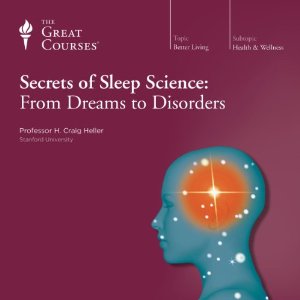Considering how much of our lives we spend sleeping, the function of sleep is still a mystery. Good sleep provides a healthy and productive waking life, while a lack of sleep impairs cognition and leads to psychological issues. Even just a few nights of inadequate sleep can cause severe damage, especially when a car is involved. Stanford University professor H. Craig Heller presents a series of 24 thirty-minute lectures that cover a wide variety of sleep topics, including circadian rhythms, the sleep cycle, sleep disorders, the role sleep plays in forming memories, and his own research, which shows a promising link between sleep-related systems and learning disabilities associated with Down Syndrome.
Secrets of Sleep Science is surprisingly technical, and, compared to other Great Courses I’ve consumed, only the Higgs Boson and Beyond contains more scientific terms and jargon of the field. The field of sleep science took off in 1929, with the invention of the electroencephalograph, using electrical activity of the brain to define two types of sleep, REM and non-REM.
Non-REM sleep EEG recordings show a high-amplitude, slow-wave pattern indicating that large populations of neurons are firing in synchrony.
REM sleep, frequently called “dreaming sleep,” creates a low-amplitude, fast pattern similar to a waking EEG.
I have a personal interest in the science of parasomnias (sleepwalking, night terrors, acting out dreams), but unfortunately all of them are covered by just one single lecture, with just enough time to define the terms and provide common-sense defenses for sleep walkers. Sleep apnea and narcolepsy are covered in more detail, though, so if your interest lies there, this would be a good introductory read.
My favorite parts of the course are the severe disorders, and I’ll be learning more about the sleeping sickness, which affected 5 million worldwide in the 1920’s, and the rare permanent insomnia, which results in death within months.
Recommended for those with a basic background in biology and an interest in the anatomy of the sleep cycle. If you go into the course expecting a series of detailed technical lectures, you’ll find an abundance of both interesting case studies and practical advice for good sleep!
